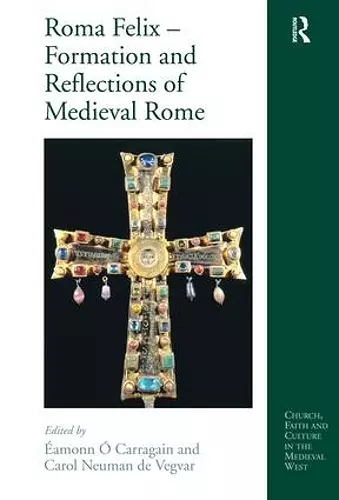Roma Felix – Formation and Reflections of Medieval Rome
Carol Neuman De Vegvar editor Éamonn Ó Carragáin editor
Format:Hardback
Publisher:Taylor & Francis Ltd
Published:14th Mar '08
Currently unavailable, and unfortunately no date known when it will be back

After the Roman empire fell, medieval Europe continued to be fascinated by Rome itself, the 'chief of cities'. Once the hub of empire, in the early medieval period Rome became an important centre for western Christianity, first of all as the place where Peter, Paul and many other important early Christian saints were martyred: their deaths for the Christian faith gave the city the appellation 'Roma Felix', 'Happy Rome'. But in Rome the history of the faith, embodied in the shrines of the martyrs, coexisted with the living centre of the western Latin church. Because Peter had been recognised by Christ as chief among the apostles and was understood to have been the first bishop of Rome, his successors were acknowledged as patriarchs of the West and Rome became the focal point around which the western Latin church came to be organised. This book explores ways in which Rome itself was preserved, envisioned, and transformed by its residents, and also by the many pilgrims who flocked to the shrines of the martyrs. It considers how northern European cultures (in particular, the Irish and English) imagined and imitated the city as they understood it. The fourteen articles presented here range from the fourth to the twelfth century and span the fields of history, art history, urban topography, liturgical studies and numismatics. They provide an introduction to current thinking about the ways in which medieval people responded to the material remains of Rome's classical and early Christian past, and to the associations of centrality, spirituality, and authority which the city of Rome embodied for the earlier Middle Ages. Acknowledgements for grants in aid of publication are due to the Publication Fund of the College of Arts, Humanities, Celtic Studies and Social Sciences at University College Cork; to the Publication Fund of the National University of Ireland, Dublin; and to the Office of the Provost, Ohio Wesleyan University.
’... a felicitous and rich blend of traditional approaches (textual exegesis and stylistic analysis) with gender studies and issues of audience, meaning, ritual and reception... Roma Felix is an important collection of papers, with a coherence which belies their varied origin.’ The Art Newspaper ’... the editors have successfully accomplished a demanding enterprise, producing a readable, richly informative, and thought-provoking volume, which will be invaluable for scholars and students alike, and will be of interest to everyone who is fascinated by both the multifaceted and multilayered culture of medieval Rome, and its impact on medieval Europe.’ H-Italy ’Roma Felix is a handsomely presented and rewarding volume. ... The papers add up to a fascinating exploration of Rome the place and Rome the idea.’ Journal of Medieval Archaeology ’... at once scrupulously edited and spendidly produced... The production values of the volume are high. the numerous illustrations (over sixty, including musical notation for Dyer's piece) are printed on the most relevant page, as are the sometimes lengthy footnotes. Altogether it is a fine addition to the substantial series of which it is part.’ Church History 'The book is unusually coherent, with individual contributions of uniformly high quality... The editors have presented a fine and valuable book. If I occasionally put a question mark in the margin, that is merely a tribute to how engaging the papers are, and how lively is the ongoing discussion of Rome itself and of its reception.' Thomas F.X. Noble, University of Notre Dame, IN, in English Historical Review
ISBN: 9780754660965
Dimensions: unknown
Weight: 929g
368 pages